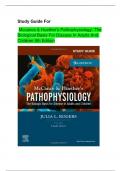Study Guide For
Mccance & Huether’s Pathophysiology: The
Biological Basis For Disease In Adults And
Children 9th Edition
, Contents
PART ONE BASIC CONCEPTS OF PATHOPHYSIOLOGY
Unit 1 The Cell
1. Cellular Biology, 1
2. Genes And Genetic Diseases, 5
3. Altered Cellular And Tissue Biology, 11
4. Fluids And Electrolytes, Acids And Bases, 17
Unit 2 Mechanisms Of Self-Defense
5. Innate Immunity: Inflammation And Wound Healing, 25
6. Third Line Of Defense: Adaptive Immunity, 33
7. Infection And Defects In Mechanisms Of Defense, 39
8. Stress And Disease, 47
Unit 3 Cellular Proliferation: Cancer
9. Biology, Clinical Manifestations, And Treatment Of Cancer, 53
10. Cancer Epidemiology, 63
11. Cancer In Children, 69
PART TWO BODY SYSTEMS AND DISEASES
Unit 4 The Neurologic System
12. Structure And Function Of The Neurologic System, 73
13. Pain, Temperature, Sleep, And Sensory Function, 77
14. Alterations In Cognitive Systems, Cerebral Hemodynamics And Motor Function, 85
15. Disorders Of The Central And Peripheral Nervous Systems And The Neuromuscular Junction, 95
16. Alterations Of Neurologic Function In Children, 107
Unit 5 The Endocrine System
17. Mechanisms Of Hormonal Regulation, 113
18. Alterations Of Hormonal Regulation, 117
Unit 6 The Hematologic System
19. Structure And Function Of The Hematologic System, 131
20. Alterations Of Hematologic Function, 135
21. Alterations Of Hematologic Function In Children, 147
Unit 7 The Cardiovascular And Lymphatic Systems
22. Structure And Function Of The Cardiovascular And Lymphatic Systems, 153
23. Alterations Of Cardiovascular Function, 157
24. Alterations Of Cardiovascular Function In Children, 177
Unit 8 The Pulmonary System
25. Structure And Function Of The Pulmonary System, 183
26. Alterations Of Pulmonary Function, 187
27. Alterations Of Pulmonary Function In Children, 199
Ix
Contents
,Unit 9 The Renal And Urologic Systems
28. Structure And Function Of The Renal And Urologic Systems, 205
29. Alterations Of Renal And Urinary Tract Function, 209
30. Alterations Of Renal And Urinary Tract Function In Children, 219
Unit 10 The Reproductive Systems
31. Structure And Function Of The Reproductive Systems, 225
32. Alterations Of The Reproductive Systems, Including Sexually Transmitted Infections, 229
Unit 11 The Digestive System
33. Structure And Function Of The Digestive System, 243
34. Alterations Of Digestive Function, 247
35. Alterations Of Digestive Function In Children, 261
Unit 12 The Musculoskeletal And Integumentary Systems
36. Structure And Function Of The Musculoskeletal System, 267
37. Alterations Of Musculoskeletal Function, 271
38. Alterations Of Musculoskeletal Function In Children, 285
39. Structure, Function, And Disorders Of The Integument, 291
40. Alterations Of The Integument In Children,
303Answers To Practice Examinations, 309
X
Contents
, SECTION ONE UNITE TITLE OR SECTION TITLE
Cellular Biology
FOUNDATIONAL OBJECTIVES Refer To Figures 1-16 Through 1-24 And
Table 1-4.
After Reviewing This Chapter, The Learner Will Be
Able ToDo The Following:
9. Describe The Changes In The
Plasma Membrane That Result In
1. State The Functions Of A Typical Eukaryotic
An Action Potential.
Cell.
Review Pages 21-22; Refer To Figure 1-
Review Pages 2-3.
25.
2. Describe The Structure And Function Of The
NucleusAnd Identify The Cytoplasmic
Organelles.
Review Page 3; Refer To Figures 1-1 And 1-2
AndTable 1-1.
3. Describe The Structure And Function Of The
Plasma Membrane.
Review Pages 3 And 5-7; Refer To Figures 1-3
Through1-5 And Tables 1-2 And 1-3.
4. Describe Cellular Receptors.
Review Pages 7-8; Refer To Figure 1-6.
5. Identify The Three Mechanisms That Bind
CellsTogether.
Review Pages 8-9; Refer To Figures 1-7 And 1-8.
6. Describe The Primary Modes Of Chemical
Signaling.
Review Pages 9, 11, And 13 Refer To Figures
1-9
Through 1-12 And Table 1-3.
7. Describe Cellular Catabolism And The
Transfer OfEnergy To Accomplish Other
Cellular Processes.
Refer To Figures 1-13 Through 1-15.
8. Differentiate Between Passive And Active
Transport, Between Endocytosis And
Exocytosis,And Between Phagocytosis And
Pinocytosis.




